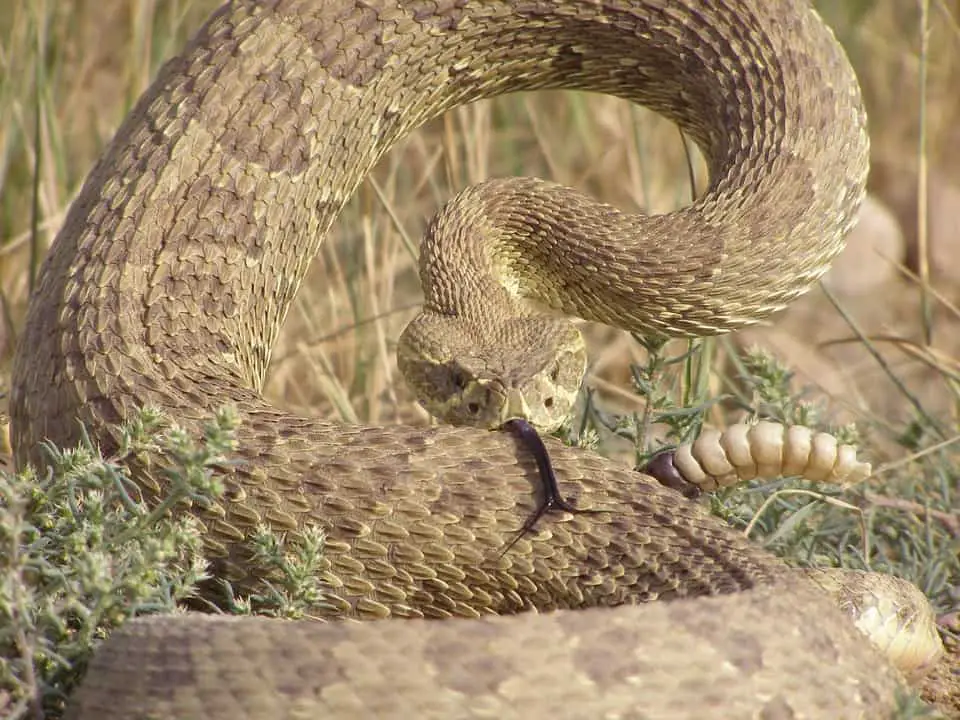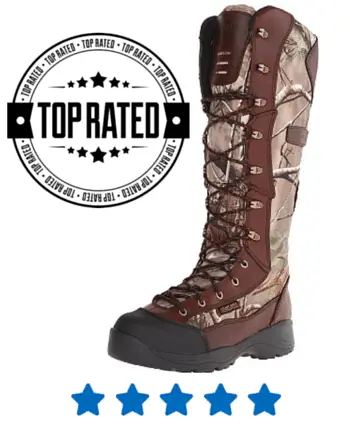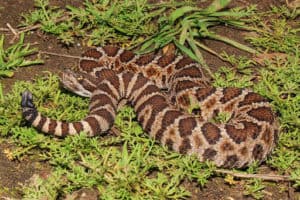
Despite our amazing 20,000+ word article that we still brag about being the most comprehensive blog post on US venomous snakes, or the follow up articles about how to identify a coral snake or copperhead look-alikes, there were still apparently plenty of questions remaining about venomous snakes. In fact, we receive plenty of e-mails asking what are actually some pretty good dang questions when it comes to snakes, especially rattlesnakes!
These are going to be the most common venomous snakes that people can run into in the United States because they’re found virtually everywhere, have so many different species, and while threatened in some areas, they thrive in many others.
There are many differences between species and sub-species, but you don’t even have to go that deep to learn some really interesting things about these pit vipers.
Do you wonder if rattlesnakes hibernate or not? Ever wanted to know if rattlesnakes like water or climb trees?
We answer these questions so read on to find the answers to all your questions and plenty of more interesting rattlesnake facts!
Table of Contents
Do Rattlesnakes Hibernate?
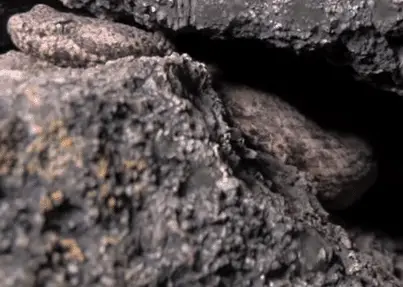
Questions about snake hibernation come up a lot in general, and rattlesnake hibernation habits (or questions if they have any at all) seem to be a special area of interest for a lot of outdoor adventurers. So do snakes hibernate?
The answer is a conditional yes. Or you could go with “It really does depend.” In locations that tend to be very warm all year round they may hibernate very little or even not at all. It’s also worth noting at this point that technically rattlesnakes don’t hibernate but they “brumate” and that period of brumation is an extended dormancy.
In other words it is the rattlesnake version of hibernating. But brumation is the technically correct term.
When the winter weather comes in and temperatures drop over the long term, rattlesnakes will brumate. Generally speaking, they tend to do this in large numbers in underground dens where available. They can huddle together in numbers that can go to hundreds or even over 1,000 snakes. Rattlesnakes will be dormant through the majority of winter.

These dens in an area are often used year after year, so once cold weather sets in there is even a time of “migration” for rattlesnakes to find their way back.
So much of how rattlesnake hibernation works depends on the average temperatures and lengths of a cold season in an area. Many rattlesnakes in Mexico don’t brumate at all. Some in higher Rocky Mountain areas or Appalachian Mountain area will be that way for many months at a time, while others will brumate for as little as a few weeks or a couple months.
So in general rattlesnakes hibernate when it gets cold. Rattlesnakes come out of hiberation when it gets warm again. Like many other types of snakes, rattlesnakes also rest and seek cover when it is especially hot or dry “aestivate” which is why they are hard to find during the day in the hottest and driest summer months in the desert.
Fun facts: Rattlesnakes will often share their dens with other snakes and even other animals like mammals (brave little guys at that point, IMO) during brumation. In addition, how often the female rattlesnakes give birth depends on climate.
If they have long brumations, most will only give birth every couple years. Non-existent brumations often means yearly births.
Do Rattlesnakes Like Water?
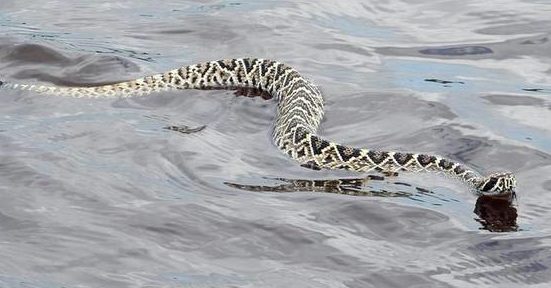
This is a question that comes up a lot, and it’s kind of weird to wonder where all the confusion comes from. Most snakes are good swimmers and just because one venomous snake is infamous for being able to swim or bite swimmers (water moccasin) doesn’t disqualify the rest!
To the question of do rattlesnakes swim or not: of course!
Rattlesnakes are very good swimmers and can even manage to coil and strike while in water. In fact you can Google “Rattlesnake tries to get on boat” and get a large number of news stories about this very thing happening.
Rattlesnakes may be swimming to get away from a predator, to chase prey, or to attempt to move from one area to another for a variety of reasons.
There’s even an instance of a fairly large rattlesnake showing up on a South Carolina beach from the ocean. It seemed dazed and was probably washed out down a river near the coast before managing to get back to shore.
So, yeah, rattlesnakes can definitely swim.
How Many Species of Rattlesnakes Are There?
There are currently 32 known species of rattlesnakes with at least 67 currently recognized sub-species found in the Western Hemisphere where they are native, though far fewer are actually found in the United States.
Rattlesnakes are only native to the Western Hemisphere. That means every species of them is found in North or South America, and unlike many other snakes found in the Americas they thrive in a surprisingly wide number of habitats.
Depending on which species are common in an area some are very large snakes while others are amazingly small. A couple species are known for being really aggressive while others don’t have a confirmed case of a bite in decades. That is a crazy variety.
In the United States Arizona is home to the most species with 12 while Alaska, Hawaii, and Maine have none (although there have been arguments on whether Maine may have some small isolated populations at the bottom of its borders.
If you want the full list with scientific names you can check out this Wikipedia page for the very barebones basics.
What Are the Most Dangerous Rattlesnakes?
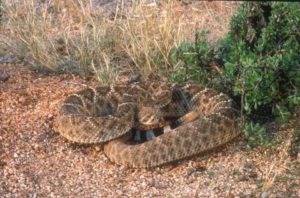
There are actually a few different answers when it comes to the question of which rattlesnakes are most dangerous – and there’s a good reason for that. One of the big ones is that the venom between different species of rattlesnakes can be radically different. For example venom A might be more likely to kill you, but also be quickly treated with the proper anti-venom.
Venom B isn’t likely to kill you unless untreated, but it is 5x more likely to cause permanent nerve, muscle, or tissue damage.
So which one is more dangerous?
The same thing happens when looking at volume of venom. Rattlesnake A might have a much deadlier venom, but puts relatively little of it into a bite because it’s small. If Rattlesnake B is an 8 foot long Diamondback Rattlesnake, a full bite is going to be flooded with a huge amount of venom, making that a deadlier bite even if the venom itself isn’t technically as dangerous in equal amounts to Rattlesnake A’s.
Even with those exceptions out of the way, there are some good rule of thumb answers. Which rattlesnake is the most dangerous? Depending on how you measure that there are three species (in the United States) that are always top of the list.
The Tiger Rattlesnake
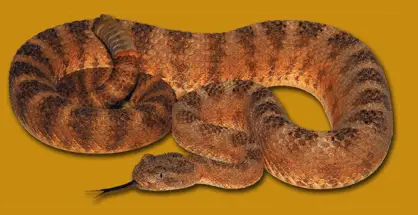
Very sparsely found in the United States (in fact they are only found in a small section of Arizona with the rest of the population found in areas in Mexico) these rattlesnakes very rarely live in an area with a lot of humans around and so there isn’t much interaction between the two. This is part of the reason so few people have even heard of the tiger rattlesnake.
The best description for this one? Maybe cantankerous. Sometimes outright aggressive. In other words, this species of rattler bucks the trend. They are more likely to aggressively defend territory and take a shot at anything in the area perceived as a threat.
They also are right up there with the Mojave as having the most toxic and dangerous venom of any rattlesnake. The venom from a tiger rattler attacks the muscles and the nerves. Outright muscle necrosis is a common symptom after a timber rattler bite.
This, coupled with their easily excitable and unusually aggressive demeanor, makes them an easy choice as one of the most dangerous rattlesnakes out there even if extremely sparse contact with humans makes bites very rare.
The Diamondback Rattlesnake
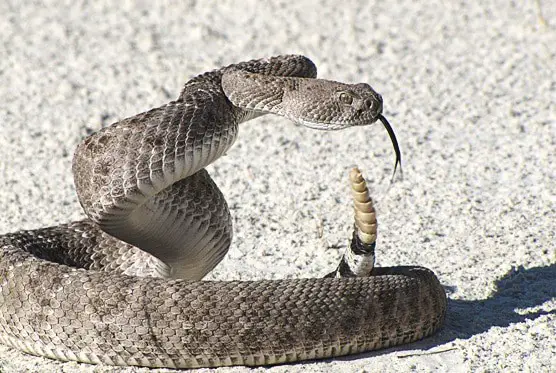
This is a bit of a cheat as it combines the Eastern Diamondback Rattlesnake and the Western Diamondback Rattlesnake. However if there are any two sub-species of rattlers that can be grouped together, these are two very related sub-species that make sense to put together.
Diamondback rattlesnakes are responsible for more rattlesnake bites in the United States than any other species of rattlesnake. This is in part due because of their wide habitat areas but also because they tend to be the largest rattlesnakes and they know it. This means less fear of people, and more of a willingness to be aggressive if harassed.
The venom of the diamondback is potent, and the fact that these rattlers grow to huge lengths means when they strike there is that much more venom injected which makes the bite even more dangerous.
In fact if most dangerous means the most people severely injured or killed by snake bite in the United States then the Diamondback Rattlesnakes take the crown by far. In the U.S. they are consistently responsible for:
- The most bites from rattlesnakes
- The largest number of severe injuries from snake bite
- The majority of deaths in the United States from snake bite
The Mojave Rattlesnake
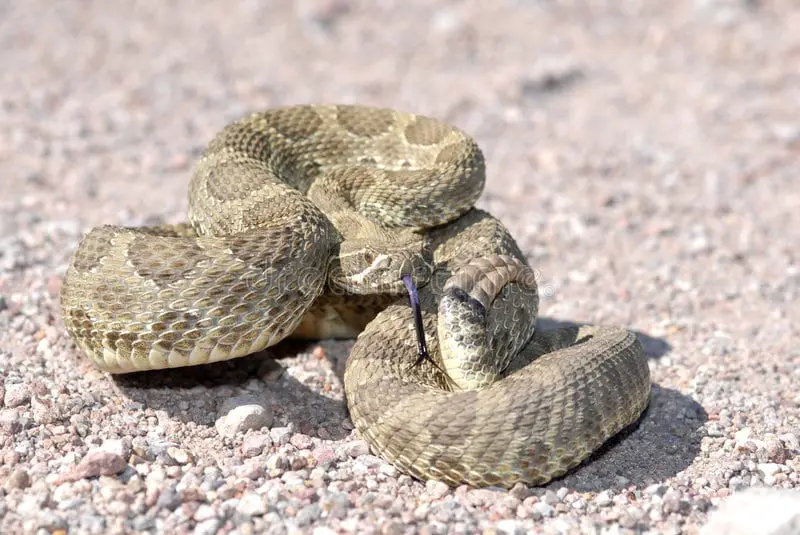
Then there’s the Mojave Rattlesnake. Many people would argue that in practicality this is the most dangerous rattlesnake of them all, and they can make a really good argument for that point. The Mojave rattlesnake has one of the most dangerous venom samples of any rattlesnake. Only the tiger rattlesnake’s venom competes with it, in fact.
This is even before taking into consideration that Mojave has two or even three different types of venom. That can make treatment especially difficult. This is especially true considering you can’t tell by sight which Mojave has which venom.
One type of venom is hemotoxic, which most rattlesnake venom is. Even this type of more “common” venom from the Mojave tends to be very potent. One type of venom is neurotoxic, adding an entirely new level of how it attacks the human body. There are even some signs from study that there might be a population of Mojave rattlers whose venom is an insane combination of both!
Add in the fact that the Mojave rattlesnake tends to be very territorial and that’s a nasty combination. While their largest populations are often in desert areas away from people, when a person does come across a Mojave it’s not unusual for some of these rattlers to get very aggressive when a person stumbles across them during the wrong time.
There’s a great video on the Mojave rattlesnake to check out.
Seek immediate medical attention
No matter which rattlesnake bites you, it’s important to seek immediate medical attention. All rattlesnake bites can be fatal, but in the overwhelming majority of cases if you get treatment within 30 minutes of the bite everything will be fine. Also read this article on why you should never use a snake bite kit.
Important Note: Something like 99% of the time the far majority of rattlesnakes are going to want to be left alone and simply choose to stay away from people (or get away when stumbled upon) given the chance.
Yes, there always are exceptions of aggressive snakes, territorial snakes, or the occasional one seeming to “attack” aggressively for no reason but these are the overwhelming exceptions! The best defense is to stay away or back away very slowly out of reach. But when that ‘s not an option, make sure to protect yourself which brings us to…
How Do I Protect Myself from Rattlesnakes?
There are actually a few options when it comes to protecting yourself from potential snake bites. While the best defense is staying aware of your surroundings and minimizing your contact with snake country, sometimes that just isn’t going to be a viable option. This is where your top three snake protection options come into play.
And honestly, we’re huge on the first two and a bit lukewarm on the third. However if you want to safely handle rattlesnakes you’ll need professional reptile tongs. The first two focus on preventing snake fangs from getting purchase. The last one is for safely handling, moving, or removing these reptiles.
Obviously if you deal with venomous snakes you need to take all necessary precautions. Most professionals handling snake tongs will also have snake boots or gaiters on. Additional protection is always important, especially if you’re going to be in an isolated area.
Snake Proof Gaiters
This is probably the most popular form of venomous snake protection in the United States. Gaiters are adjustable, cover everything from ankle up to knee, and wrap around. Since the majority of venomous snake bites occur on the lower leg, this offers some serious protection.
While not perfect, seeing as how a bad hand placement could cause a bite while rock climbing or moving over some downed trees and brush, snake gaiters are going to provide the best overall protection.
These are often preferred to snake boots because they are wrapped around the legs and or boots. This means they can be made to fit both firmly and comfortably. Solid 360 degree lower leg protection that fits perfectly – that’s a pretty good deal! And that’s even before the peace of mind that comes from being protected from snake fangs.
These are favorites among many outdoorsman as well as ranchers who often find themselves in snake country.
Even for professional snake handlers who use reptile tongs, these gaiters are an important part of the setup. When dealing with venomous snakes extra layers of protection is never a bad thing. Make sure you are fully protected.
Snake Proof Boots
There are many individuals who aren’t as big on the snake gaiters and feel that extra layer outside of the boot just feels clumsy or off. For some climates, an extra layer might not be practical or viable. Ranchers, hunters, and others can deal with the sweat that comes from a pair of boots. Adding more layers in a hot climate can be an entirely different story altogether.
However, putting on a pair of boots is easy, and a pair of good snake boots that fit perfectly offer about the same level of protection. You get a bit more protection on the feet and ankles while there might be a touch less on the lower knee depending on the fit.
A good pair of snake boots is definitely worth the purchase. This is just when thinking about the peace of mind and natural protection. That doesn’t even take into account how costly a trip to the emergency room is.
In most cases, over $10,000. That’s enough for 40 pairs of even the most expensive snake boots.
These are designed to add that extra protection that you want from hiking boots, ranching boots, hunting boots, or even cowboy boots, but that aren’t guaranteed. The proper use of better materials and designs here keeps your lower legs safe.
Snake Handling Tongs
For most of us being protected from a venomous snake bite is what we’re really looking for. Not many of us are going to go out of our way to mess with a snake. On the other hand there are a few brave souls who actually seek them out.
In this case, they need to not only have snake proof gaiters (or at a minimum anti-snake bite boots) but they also will want professionally made snake handling tongs. These allow them to grab and hold the snake at a distance. When used correctly, they should be able to prevent snakes from striking at you.
These snake tongs vary in length but generally start at 28 inches in length and can be as long as 72 inches, though not every company makes them that large. For most people, something from the 36 to 54 range will be more than enough.
To need more than that would mean dealing with some serious sized venomous snakes. Also keep in mind that the longer the tong, the more arm strength is needed to safely handle it. A fat 8 foot long rattlesnake at the end of a 72 inch set of tongs will test even many strong men to their limits.
Whether gathering rattlesnakes for a bounty, for safe removal, or pest control, you want to make sure you have the right equipment. These tongs can make sure all venomous vipers stay at more than striking length.
How Do I Treat a Rattlesnake Bite?
This is one of those questions that can be hard to answer because the “proper first aid” changes over time as more information is gathered. In fact, when Jon and I were both in Boy Scouts the standard first aid was a constrictive band about 1.5 inches above where the bite took place.
However, it seems like as of 2018 (it may be earlier when this change took place, but for sure by 2018) this has changed again. Pointing out that in most cases the constrictive band doesn’t seem to slow the spread of venom in the body and may increase damage in that localized area, that’s no longer recommended.
The current first aid for a rattlesnake bite is:
- Move to a point of safety away from the snake or snakes in the area
- Breathe deeply and calmly to keep the heart rate down
- Take off or loosen any constrictive clothing on the body
- Call in an ambulance or aid while staying still OR if that’s not an option use a slow pace and deep breathing to make your way to a vehicle or someone who can call for help
- Get to a hospital or clinic for treatment ASAP
- Call ahead, if possible, to let them know about the rattlesnake bite
- Get the proper antivenom under medical supervision
That’s it. No tourniquets, no cutting, no constrictive bands. Loosen up anything that can be tight on the body, control your breathing, and get help.
Do Rattlesnakes Climb Trees?
This is a bit of a terrifying thought, isn’t it? Generally speaking rattlesnakes choose not to climb trees or walls or fences, but that doesn’t mean they can’t. More than happy to stay on the ground an overwhelming percentage of the time there are exceptions. This tends to be especially true in areas with “sloped” or low hanging trees and branches that make it much easier to scale a tree. At least compared to a vertical climb.
While climbing trees isn’t in the normal bag of tricks for a rattler, sometimes it does happen. Case in point is the story of this unfortunate fellow in South Carolina. He was kayaking with friends when a rattlesnake fell out of a tree and attacked him twice.
So yes, rattlesnakes can climb trees. It’s not common, but they can do it.
Do Rattlesnakes Lay Eggs?
This is one of the areas where rattlesnakes are really interesting in that they go off the beaten path from most snakes. Rattlesnakes don’t actually lay eggs like most reptiles. The baby rattlesnakes develop within the mama rattler’s body. These are some of the few snakes that give live birth. Therefore, rattlesnakes do not lay eggs.
So this naturally also answers the common question of “Are rattlesnake eggs edible?” No, because there’s no such thing as a natural rattlesnake egg.
Are Rattlesnakes Endangered?
Generally speaking no, but there are exceptions. The reason this question is hard to answer is because in many areas there’s a real “feast or famine” to the population numbers. In other words they’re either very healthy as a population, or they’re extremely limited as a population.
Some species are endangered or at least threatened. What is more common is to have a situation where the overall population might be fine, but pockets are endangered. For example the timber rattlesnake is not endangered – but it is a protected species in Indiana. That’s because their population is pretty sparse in that state.
Another big example would be the Eastern Massasauga Rattlesnake. This snake has very healthy populations and a widespread habitat, but in the state of Iowa they are extremely endangered and can be found only in one very small swamp area. That’s it.
Why Do Rattlesnakes Have Rattles?
Evolutionarily speaking scientists don’t know the answer to this question. However the guess is that this was a warning to larger animals or predators to help them avoid getting stepped on. After all they don’t rattle when hunting prey, only to warn off larger creatures or potential threats.
Why would rattlesnakes not rattle?
There are several reasons why a rattlesnake might not rattle before striking. First, it’s important to understand that they don’t always have to rattle before attacking. This is a common reaction but like so many things in life, it is no guarantee.
The rattle of an adult rattlesnake might be damaged or broken. They may be so surprised they jump straight to striking out of defense. There are also a few small species whose rattle sounds like a hum or a buzz, meaning they might be trying to create a warning but you don’t hear it. Or it at least doesn’t register as a rattle.
And sometimes they simply don’t rattle.
Is there a rattlesnake with no rattle?
No. However baby rattlesnakes can be hard to hear because their rattles are much smaller and there is one species of rattlesnake (the aptly named pigmy rattlesnake) so small that many people can’t tell it’s a rattlesnake. It’s warning rattle often sounds like more of a hum or buzz.
More Rattlesnake FAQ
Q: Are young rattlesnakes really more dangerous because they can’t control how much venom goes out in a bite?
A: No. This is a myth. Larger snakes produce more venom than smaller ones and their bites are going to be more dangerous. Rattlesnakes of any age can choose to envenomate or not, so youth really has nothing to do with high danger levels.
Q: Can denim jeans stop a rattlesnake bite?
A: No. While some tests have shown that denim jeans can lessen the amount of venom that makes it into the wound, they will not straight up stop a snake bite. We go into more detail in this article on will denim stop a rattlesnake bite (I know, topical, right?) and while tough denim jeans are a helpful precautionary measure, they’re not enough by themselves.
Q: What’s the best protection from rattlesnake bites?
A: We’re big fans of snake proof gaiters followed by a solidly built (and good fitting) pair of snake boots. Have those to protect your lower legs where most bites take place. Keep an eye out for signs in snake country with protective gear and you’ll likely be alright. Nothing is 100% but you can shift the scales in your favor.
Q: Are rattlesnakes naturally aggressive?
A: Most of them are not. Some are a bit more aggressive than others. Species like the Mojave, diamondback, and tiger all tend to be a bit more aggressive or territorial. Snakes tend to be more aggressive during their active breeding season, as well. This does mean that there are cases where some rattlesnakes are going to tend to be more aggressive.
That being said, most rattlesnakes would rather just be left alone.
Q: What’s the best way to protect from rattlesnake bites?
A: There are multiple options. Snake proof boots are a very popular option and very widely known. Snake gaiters are probably even more popular and equally as effective. If for some odd reason you need to gather them, snake tongs will also be important.
Above all else, paying close attention to your surroundings is crucial. This will help stop a potential snake problem before it starts.
Q: Why do people bury rattlesnake heads?
A: So the old story about rattlesnake heads being able to bite and envenomate you after the snake is dead? 100% true. Because of the reaction of the heat sensors a rattlesnake’s head can strike hours after death. Those bites can still be lethal.
This is why many people will bury a rattlesnake head. This makes sure it can’t strike anyone by accident. Or strike animals. They can decompose safely underground at that point.
Q: Do rattlesnakes always rattle before they strike?
A: Nope. There are a variety of reasons why a rattler might rattle in warning. There are also plenty of reasons why they might not.
Q: Can rattlesnake venom kill another rattlesnake?
A: No. Rattlesnakes actually rarely strike at each other even when fighting, they tend to fight in a twisting, wrestling sort of way for dominance. Snakes are almost always immune to venom of the same species, but can be extremely susceptible to venom from other species of venomous snakes.
Q: Will a rattlesnake bite kill a dog?
A: If the bite has venom and isn’t a dry bite (and you should always go under the assumption that it’s not), then a rattlesnake bite will often be fatal for dogs if untreated. Even if not fatal, they can do extreme harm. And dog that gets bit should absolutely be taken to a vet as soon as possible for anti-venom treatment.
Q: What is worse: rattlesnake or copperhead?
A: Copperheads are much more aggressive and also tend to be so well camouflaged that many people get too close without knowing until the bite already has taken place. Copperheads are responsible for the most venomous snake bites per year by far in the United States.
However virtually no one dies from a copperhead bite without extenuating circumstances. On the other hand almost every rattlesnake bite could be fatal without treatment. They bite far less people, but the impact can be much more deadly. So the final answer to this question depends on your definition of worse.
Q: Can rattlesnakes “jump?”
A: This is one of those myths that strangely sticks around. The short answer is that, no, rattlesnakes can’t jump. That being said, a fully extended strike from the coiled position can certainly look like a jump. This can especially be true if the violence of the strike pulls the back of its body forward with it. From a certain angle that would definitely look like a “jump.”
Is this where the myth comes from? While impossible to track down the answer for sure, that is a really solid guess.
Q: Are there any rattlesnakes in Maine?
A: While there are some disagreements on this one, the general consensus is that there are no rattlesnakes in Maine. Most evidence to the contrary is anecdotal and there are a couple of common species of snakes in Maine that are often “mimics” and defend themselves by mimicing the larger more venomous rattlesnake so there is a good chance many of those eye witness accounts are false sightings.
Q: Can’t I just use a snake bite kit?
A: Absolutely not! Snake bite kits don’t work. We don’t sell them, we don’t promote them, we’re admit that these should not be used in any circumstances to treat a snake bite. Check out that link for a more in-depth study if you don’t believe us.
In Conclusion
While there are many rattlesnake questions out there we hope this helped put a dent into the list. Between the previous articles we published and this one, there’s a lot of information. If we haven’t answered your rattlesnake questions by now then good luck finding the answer!
These are fascinating snakes. It doesn’t come as any surprise to us that there are so many questions about them flooding our e-mail box!

